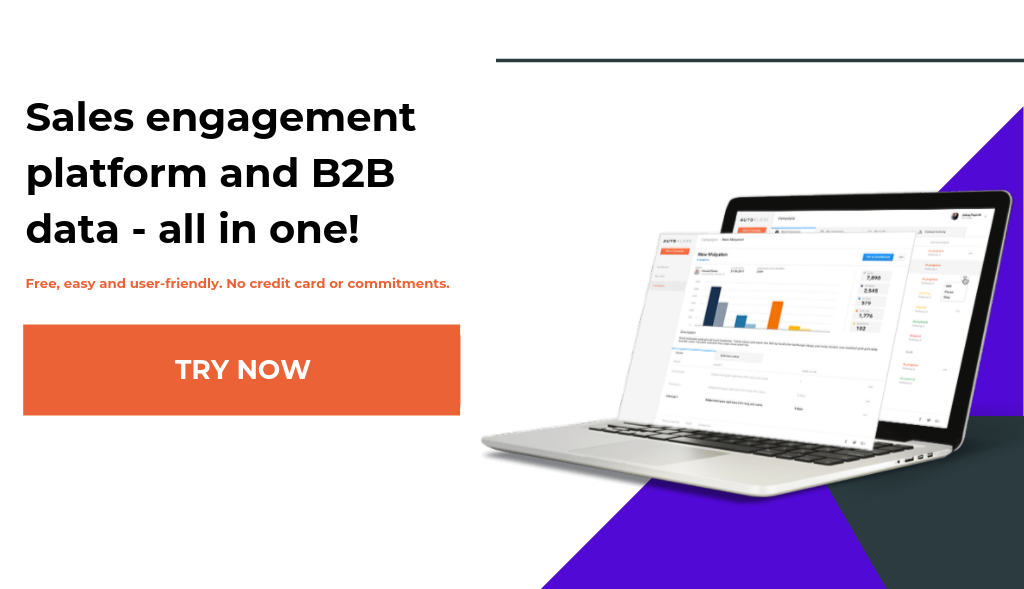
Cold outreach isn’t an easy game to play. You’ll encounter numerous rejections that can be disheartening, but it becomes even more frustrating when your recipients consistently ignore your emails.
You can take into consideration the fact that people busier nowadays than they have ever been, as well as that their inboxes are flooded with numerous emails every day.
Yet, that can’t be an excuse.
Your cold outreach shouldn’t result in constantly getting cold shoulders.
So, before you give up on all the benefits that email outreach can bring you, here’s a checklist of the most important factors that can get your prospects to click on that “Reply” button.
But first things first.
Before we delve into this important topic, it’s crucial to answer the following question: What is a good email response rate?
Many email marketers will tell you that they aim for 10%, but it can vary depending on your industry and how experienced you are. You shouldn’t get upset if sometimes your response rate is 5%, but if it goes below that, it’s a good idea to check different parameters and elements of your email campaign and try to identify potential culprits.
For example, maybe your subject line is weak, or you failed to provide a strong CTA, or the offer itself leaves much to be desired.
But, worry not. We’re here to help.
1. Your Contact List Is Bad
In order for your recipients to respond to your emails, they first need to get it. In other words, you need to have correct information about your prospects.
This might seem obvious, but that many people aren’t even aware that their contact lists extremely inferior in terms of quality.
Getting a lot of hard bounces is definitely a red flag.
People change jobs, positions within their company, email addresses, and phone numbers, and all these transitions leave you with a list full of outdated data.
You probably already know that buying lists from shady sources on the internet is a big no-no, but even the list you yourself have built needs regular scrubbing and updating.
Besides outdated contact information, these lists are riddled with different kinds of spelling errors and typos, and if you simply import them into your email automation platform, you might end up sending an email which says “Hi peter,” or “Hello Marc” to a Mark. All these mistakes might seem insignificant, but as you know the devil is in the detail, and with such a nonchalant approach you can’t expect that your email will be taken seriously and you will more than likely not get a response.
If you aren’t sure whether particular email addresses are correct, check out this blog post on how to find every email you might ever need.

2. You’re Reaching Out to a Wrong Audience
Having correct email addresses and other information about your prospects alone is not enough.
You have to know who will be interested in your offer and email only those people who could benefit from it.
Yes, this will limit your audience, but at the same time, it will make sure that your prospects are engaged and responsive.
So, the first thing to do is create your ideal customer profile (ICP) – a description of a company (or individuals) that are a perfect fit for your business. It should contain different information such as the industry, location, company size, or pain points, among others.
After this basic information, it’s also crucial to obtain details such as whom to reach out to in the company as well as who decision-makers are.
Apart from having a general outline of your target audience, it’s also worth noting that you won’t send the same email to all of them.
If you want to generate responses, your message needs to be highly personalized and relevant to the people who receive them.
In other words, you have to additionally split your list into different segments and tailor your outreach accordingly.
3. Your Subject Line Isn’t On Point
Subject lines are a frequently discussed topic, because they’re of critical importance for the success of your emails.
And yet, if you take a look at your inbox you’ll find a lot of irrelevant, poorly structured subject lines, while some emails won’t even contain this crucial element.
There are some great articles which cover the anatomy of a good and hard-to-ignore subject line, such as this one about 37 networking subject lines, or this one with the most effective sales email templates with examples.
Subject lines also have to be relevant to the particular audience segment that you’re addressing and spark their interest, but no matter what you do, the one thing you should avoid is coming up with a subject line which is deceptive and misleading.
Yes, it has to be catchy and intriguing, but it should give a teaser of what you’re going to talk about in your email. So, no – tricking your recipients into opening your email by telling them something totally different from what your message is about isn’t creative and resourceful.
It’s deceptive and you’ll maybe get them to open your email once, but after that, your emails will be going to spam directly.
Speaking of spam, there’s another thing that you should know: many words and phrases that marketers use when they’re trying to capture the attention of their recipients raise red flags and activate spam filters.
Given that besides some obviously spammy words and phrases, such as “cash rewards” or “win $1,000,000”, there are some pretty inconspicuous ones that are hard to spot.
For example, would you say that “an amazing offer” or “opportunity” are spam words? But, including these in your subject line is a surefire way to end up in spam folders of your recipients.
That’s one of the reasons why we developed the Autoklose Email Spam Checker which goes through your subject lines and email copy and highlights spam words. This way you can easily get rid of them and ensure that your emails will reach your prospects’ inboxes.
4. Your Email Is Elaborate
Your new feature is super awesome, I get that, and you want to tell your potential and existing customers how much they will benefit from it and mention everything they will be able to achieve.
And the next thing you know, your email is the size of an average blog post. But hey, you mentioned only the most important specs and benefits that your recipients should know.
Now, save this copy in a Word document so that you can develop it into a fully-fledged blog post, and delete it from your email editor because when your recipients open an email that they can’t skim immediately and spot its value, they’ll simply stop reading it.
Instead of that, you need to divide your email into bite-sized bullets and paragraphs and mention only the essential points.
Also, bear the purpose of your in mind and adjust the length based on that.
Prospecting emails can consist of only a couple of sentences, for example.
If you’re promoting your new product, highlight only a couple of the most important benefits, and send your prospects to your landing page where they can learn more and explore further.
Try to keep the word count below 150, but aim for even fewer.
5. You’re Trying Hard to Sell
But, isn’t that what I’m supposed to do, you ask yourself.
Yes, it is, but don’t forget that helping others should be at the core of selling. A client of ours recently asked us to do a blog post on how selling is actually all about being useful to others and helping them find solutions to their problems.
And by droning on your company and product, you’re neither providing any value nor helping your prospects.
So, instead of making your email all about you and your product, try to shift your perspective and ditch the “me, me, me” hard-sell approach.
It’s always a good idea to start a conversation by mentioning your prospects’ pain points and suggest a couple of solutions. Offer them a couple of useful reads for starters. And that’s how you get the conversation going.
6. Your Copy Is Riddled With Mistakes
A typo is something that happens to all of us occasionally.
But if you don’t have a habit of checking your emails for typos, spelling errors, and other mistakes, you’ll easily come off as unprofessional and that’s something that can erode your authority.
It’s a good idea to install Grammarly or another writing assistant to check your emails, but don’t forget to always double-check every single word you write. No matter how advanced these tools are, they can’t spot every mistake, particularly if semantics is involved.”
Do your/you’re homework and read everything you write at least one more time.

7. Your Email Templates Are Subpar
It can be hard when you have to craft email copy, and that’s the reason why many people use sales email templates.
There’s nothing wrong with this approach, especially if you’re using the copy which has already brought good results in terms of conversion.
But if your email templates leave much to be desired, if they’re not properly personalized, and so to speak wooden and artificial, they won’t resonate with your recipients. And they’ll simply click the delete button.
You cancheck our blog post and find some really effective sales email templates.
Besides that, we also have numerous premade and highly customizable email sequence templates on our platform. They can be easily personalized, and together with our personalization tokens, that you can create yourself, you can send automated emails which are the next best thing to 1-on-1 conversations.
8. You Don’t Personalize Your Emails Properly
Crafting the subject line with recipient’s name in it isn’t exactly something that could be mentioned as a pinnacle of personalization.
Do you think that people will think that you actually talk to them personally and respond to your email just because you used their first name?
Of course not.
You’ve got to cover the whole nine yards and use every information you have on them. Their location, their title, their interests, pain points, you name it.
And only that way, if you go beyond the first name, will you be able to say that your emails are personalized.
For example, if you’re going to a convention or a trade show in a particular city, send emails to the prospects who live in the area and ask them whether they will be in attendance so that you can catch up face-to-face.
“Peter, I’m coming to Seattle for a conference” is a good intro, as it will capture the interest of the particular prospect who live there. And they’ll be prompted to check out what you say in your email.
9. You Skip the Follow-Up Part
No matter whether your email campaign ticks all the boxes, if you email your prospects only once or twice, it’s doomed.
Be persistent and make sure to follow up even if you don’t get your response right away.
Your prospects are busy people and they sometimes simply forget to respond, or it maybe takes more time to capture their attention and interest, given that they receive over a hundred business emails a day.
Here’s more on how to follow up without annoying your prospects and crossing the line.
10. You’re Flooding Your Prospects’ Inboxes
Yes, we just talked about following up with your prospects and being persistent.
But, that doesn’t mean that you should spam them and send them an email message every day (or more than one, God forbid!) just for the sake of touching base and staying on their radar.
It’s true that you need to keep in touch but you also need to have a very good purpose for reaching out.
Otherwise, you’ll simply annoy your prospects and get them to hit spam whenever they see your name in their inbox – and soon, Gmail will do that automatically.
Instead of that, create an effective follow-up strategy and think about what would add value to your email messages. That may be your new feature, an interesting blog post relevant to your prospect that you’ve come across on the internet, a good podcast, or a conference that they would love to attend.
As for the number and frequency of your follow-ups, it’s important not to overstay your welcome and still don’t let them forget about you.
Check out our blog post on how to create a winning sales cadence – given that you’ll probably reach out to your prospects through different communication channels, it’s crucial to coordinate them and make sure that every call, email, or touchpoint is meaningful and relevant.
Over to You’ Inboxes
Transforming your emails into must-read messages is not rocket science; it’s a matter of dodging the pitfalls that can make your efforts go unnoticed.
By diligently refreshing your contact lists, honing in on the ideal audience, crafting compelling email subjects, and adding a personal touch, you’re not just sending emails—you’re crafting an experience. Steer clear of the typos that can undermine your professionalism, and don’t underestimate the power of the follow-up.
Embrace these guidelines, and witness the alchemy that turns your response rates from ordinary to extraordinary. Happy emailing!


